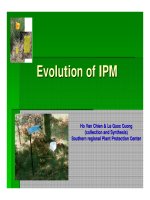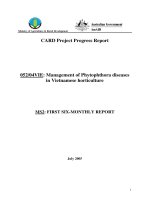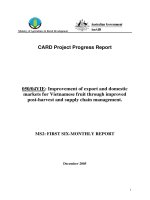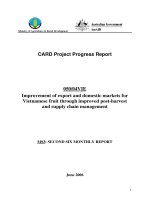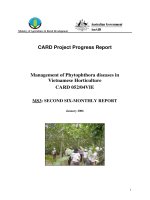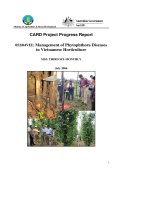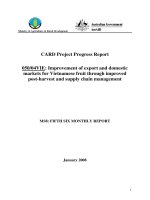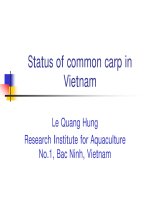Báo cáo nghiên cứu khoa học: "ESTIMATION OF SCAVENGING ACTIVITY OF PHENOLIC COMPOUNDS BY CALCULATING SPIN DENSITY DISTRIBUTION" ppsx
Bạn đang xem bản rút gọn của tài liệu. Xem và tải ngay bản đầy đủ của tài liệu tại đây (636.3 KB, 12 trang )
TẠP CHÍ PHÁT TRIỂN KH&CN, TẬP 10, SỐ 12 - 2007
Trang 57
ESTIMATION OF SCAVENGING ACTIVITY OF PHENOLIC COMPOUNDS
BY CALCULATING SPIN DENSITY DISTRIBUTION
Pham Thanh Quan, Le Thanh Hung, Tran Thi Ha Thai
University of Technology, VNU-HCM
(Manuscript Received on March 21
th
, 2007, Manuscript Revised October 16
th
, 2007)
ABSTRACT: The geometries and spin density distribution of phenolic radicals are
investigated by density functional theory (DFT) at the B3LYP level. Rusults are indicated that
spin density distribution of phenolic radicals is high at the O and C (para) positions. The
stabilization of the free radical responds to the decrease of the highest spin density (HSD) at a
position of structure radical and enhances antioxidant (radical scavenging) activity.
Calculated Highest Spin Density values (HSDs) are in good agreement with experimental
cites, thereby estimating of scavenging activity of neutral molecules can be used, especially
phenolic antioxidants.
Key words: antioxidants, phenolics, flavonoids, spin density
1.INTRODUCTION
Phenolic antioxidants form an important class of compounds which serve to inhibit the
oxidation of materials of both commercial and biological importance. The function of
antioxidants is to intercept and react with the free radicals at a faster rate than the substrate,
and since free radicals are able to attack a variety of targets including lipids, fats, and proteins,
it is believed that they are implicated in a number of important degenerative diseases including
aging itself [1].
There are two main mechanisms by which antioxidants can play their protective role. The
first is H-atom transfer, in which a free radical ROO
•
removes a hydrogen atom from the
antioxidant (ArOH) [1 - 4]:
ROO
•
+ ArOH
→ ROOH + ArO
•
(1)
The efficiency of the antioxidant ArOH depends on the stability of the radical ArO
•
, which
in turn is determined by the number of hydrogen bonds, conjugation, and resonance effects.
The bond dissociation enthalpy (BDE) of the O-H bonds is an important parameter to evaluate
the antioxidant action, because the weaker the OH bond the easier the reaction of free radical
inactivation will be.
Another possible mechanism by which an antioxidant can deactivate a free radical is
electron transfer, in which the radical cation ArOH
.+
is first formed followed by rapid and
reversible deprotonation in solution, as followed:
ROO
•
+ ArOH → ROO
-
+ ArOH
.+
(electron transfer) (2)
ArOH
.+
→ ArO
•
+ H
+
(deprotonation equilibrium) (3)
ROO
-
+ H
+
→ ROOH (hydroperoxide formation) (4)
The net result from above is: ROO
•
+ ArOH → ROOH + ArO
•
, the same as in the atom-
transfer mechanism. If the radical cation ArOH
.+
has sufficient lifetime it can attack suitable
substrates. Therefore, the radical cation arising from the electron transfering must be stable. In
this case, the ionization potential (IP) is the most significant energetic factor for the
Science & Technology Development, Vol 10, No.12 - 2007
Trang 58
scavenging activity evaluation. However, low IP values also enhance the chance of generating
a superoxide anion radical through the transfer of the electron directly to surrounding O
2
.
Recently, another mechanism has been discovered. This was named sequential proton loss
electron transfer (SPLET). It was experimentally confirmed that vitamin E and other phenols
can react with DPPH
•
(2, 2-diphenyl-1-picrylhydrazil radical) and other electron deficient
radicals (ROO
•
) by two different and nonexclusive mechanisms, H-atom transfer and SPLET.
SPLET is not uncommon for ArOH/ DPPH
•
reactions in solvents that support ionization.
SPLET can be described by these equations:
ArOH → ArO
-
+ H
+
(5)
ArO
-
+ ROO
•
→ ArO
•
+ ROO
-
(6)
ROO
-
+ H
+
→ ROOH (7)
The reaction enthalpy of the SPLET first step corresponds to the proton affinity of the
phenoxide anion (ArO
-
). In the second step, electron transfer from phenoxide anion to ROO
•
occurs and the phenoxyl radical is formed. The reaction enthalpy of this step will be denoted
as electron transfer enthalpy. Again, from the antioxidant action viewpoint, the net result of
SPLET is the same as in the two previously mentioned mechanisms, i.e., ROO
·
+ ArOH
→
ROOH + ArO
•
[5]
Those mechanisms point to the fact that the predominantly stable phenolxyl radicals
determine scavenging activity of phenolic compounds. Quantum thermochemical calculation
of the O-H bond dissociation enthalpy (BDE) is known to be successful for characterizing
antioxidant activity for a large number of antioxidant. However, there are cases where
quantum thermochemical calculations are poor, especially when steric and intramolecular
interactions occur [6].
In this study, we would like to introduce another method to study scavenging activity of
phenolic compounds based on quantitative structure activity/property relationships. The
stability of phenolxyl radicals can be predicted through calculating the spin density
distribution. Spin density is the unpaired electron density at a position of interest, usually at
carbon, in a radical. The electron density ρ(1) at the position r
1
can be described as a sum of a
density with α and β spin: ρ(1) = ρ
α
(1) + ρ
β
(1) (ρ
α
(1), ρ
β
(1) corresponds to the probability
density of finding an electron with α and β spin at the position r
1
). The radical will be stable as
the spin densities spread radical structure. This is synonymous with the Highest Spin Density –
HSD at every atom of radical is small. At the doublet state, sum of spin densities is 1.
One of the ways to measure spin density experimentally is by electron paramagnetic
resonance [EPR, ESR (electron spin resonance)] spectroscopy through hyperfine coupling
constants of the atom or attached hydrogen. One is usually however limited to
1
H hyperfine
couplings which are an indirect measure of the radicals π-electron spin density. A more direct
measure of the π-spin density could in principle be obtained by analysis of the
13
C and
17
O
isotropic or anisotropic hyperfine couplings, but these have not been reported presumably
because of difficulty of detection. Without such information, the complete spin density
distribution for these phenoxyl-based free radicals cannot be attained experimentally [7, 8]
Recent studies have shown the ability of hybrid density functional methods, in particular,
B3LYP, to help characterize free radicals. In this paper, we have investigated the density
functional level of the conformation of phenolic radicals to predict activity of their neutral
molecules by calculating the HSD values (HSDs).
TẠP CHÍ PHÁT TRIỂN KH&CN, TẬP 10, SỐ 12 - 2007
Trang 59
2.COMPUTATIONAL METHODS
All of the calculations reported in this study were performed using the Gaussian03 code
[9]. The B3LYP exchange correlation potential was used for optimizing geometries and
computing vibrational frequencies in connection with 6-31G* basis set. Single point energy
refinement on the 6-31G* optimized geometries was performed with use of the 6-311++G**
basis set.
The unrestricted open-shell approach was used for radical species. Spin contamination was
found in accepted limit for radicals, being the <s
2
> values about 0.75-0.78 in all cases.
Solvent (water) effects were computed in the framework of the self-consistent reaction
field polarized continuum model (SCRF-PCM) implemented on the Gaussian03 package,
using the UAHF set of solvation radii to build the cavity for the solute, in the gas equilibrium
geometries.
3.RESULTS AND DISCUSSION
3.3.Spin densities and Radical Stabilities
The investigated structures were separated into 3 groups and depicted in Figure 1, 2 and 3.
For clarity we will discuss separately the conformational properties and the relative stabilities
of radicals for each system and the HSD trend.
• Group 1: CX
3
radicals (Figure 1).
Many studies showed that most carbon-center free radical formed by normal oxidative
processes readily react with molecular oxygen to form peroxyl radicals. As mentioned in the
Introduction, sum of spin densities is 1 at the double state. Calculating the CX3 radicals, we
found that the HSDs of radicals were approximative 1 (structures range from 1 to 6). It was
shown that the unpaired electron mainly focused on the center carbon atom without
distributing over radical structures. Therefore, spin density was high at the C atom position
which was removed a hydrogen atom. This was corresponding to these radicals which are very
active, especially CH3• .
Because of conjugation system (in structure 7 – 9), the spin distribution was improved by
the electron delocalization. Therefore, these radicals were more stable than six previous
radicals and there was the decrease in HSDs [the minimum HSD value was 0.822 (in structure
9)].
CH
3
C
2
H
5
HC(CH
3
)
2
C(CH
3
)
3
CF
2
CF
3
(CF
3
)
2
CF
H
C(CH
3
)
3
C(CH
3
)
3
(CF
3
)
2
CF
1
2
3
4
5
6
1.146 1.093
1.018
0.926
1.181
1.012
CH
2
CH
2
OH
7
8
*
*
0.862
0.852
CH
2
OH
9
*
0.822
HSD
HSD
Fi
gure 1. Studied CX
3
radicals and their calculated HSDs.(*) the atom obtained the HSD value.
Science & Technology Development, Vol 10, No.12 - 2007
Trang 60
• Group 2: Phenolic radicals (Figure 2).
The unpaired spin density for the phenolic radicals was shown in Figure 2. Each radical
displayed an alternating pattern of spin density with high spin at the O and C (para) positions.
In general, for the phenoxyl free radicals, substituents which can delocalize this spin density
would stabilize the free radical. Such an effect is dominant for the para and ortho positions
where the spin density is high. An oxygen substituent therefore at the para position can be
expected to participate in the π-electron system and delocalize the spin density.
The calculated spin population of Figure 2 gives a more quantitative measure of such
effects. The HSDs lied at 0.370 - 0.448, lower than CX3 radicals. It could be observed that the
stable radical was correlative with the small HSDs. From these values, it was also found that
the phenolic radicals were more stable than CX3 radicals and could be expected to become
candidates for antioxidants.
In addition, it should be noted that the radicals were formed by removing a hydrogen atom
from the commercial antioxidants (butylate hydroxy anisole BHA and butyl hydroxyl toluene
BHT, structure 15 and 16) obtained the lowest HSDs, 0.370 and 0.372, respectively. So, the
commercial antioxidants have the trend of forming stable radicals.
O
CH
3
O
CH
3
O
10
11
12
*
*
*
0.425
0.455
0.426
CH
3
O
H
3
C
O
CH
3
C(CH
3
)
3
C(H
3
C)
3
CH
3
CH
3
O
13
14
15
16
*
*
*
0.448
0.435
0.370 0.372
C(CH
3
)
3
O
H
3
CO
*
HSD
HSD
Figure 2. Studied phenolic radicals and their calculated HSDs. (*) the atom obtained the HSD value.
• Group3: Polyphenolic radicals (Figure 3)
It was said that the behavior of different OH groups in polyphenolic compounds is largely
influenced by the neighboring groups and by the geometry, which are performed by the
conjugation systems and electron delocalization. That could be easily quantified through
calculating unpaired spin density.
From Figure 3, the HSDs raged from 0.348 to 0.487. It was observed that the presence of a
catechol moiety (in structure 18, 23, and 24) probably made the radicals get the small HSDs
(values were 0.348, 0.362, and 0.371, respectively). On the other hand, the commercial
antioxidant radicals (structure 20 and 21- the tert-butyl hydro quinon TBHQ radicals) also
obtained the low HSDs, 0.370 and 0.384, respectively. That was the same results compared to
other antioxidant radicals in Group 2, BHA and BHT radicals.
TẠP CHÍ PHÁT TRIỂN KH&CN, TẬP 10, SỐ 12 - 2007
Trang 61
For radicals ranging from 25 to 32, the presence of a saturated (2) ring inhibited the
electron delocalization between (1) ring and (2) ring. Therefore, spin density distribution of
those radicals were not as good as in catechol radicals. So, the HSDs slightly increased, about
0.430 – 0.487. In addition, the ortho-OH group in (1) ring followed the trend in which forming
stable radicals are compared to the para group.
Studying 3 above groups, it could be pointed to the fact that the spin density distribution
was correlated with the stability of radicals. The smaller HSDs, the more stable radicals.
O
OH
C(CH
3
)
3
20
OH
O
OH
O
OH
O
17
18
19
*
*
*
*
0.440 0.348
0.390
0.370
O
HO O
OH
O O
OH
O
C(CH
3
)
3
21
25
26
(1)
(2)
(1)
(2)
*
*
*
0.384
HSD=0.455
HSD=0.472
HSD
HSD
O
COOH
OHHO
OH
COOH
OHO
24
23
O
OHHO
22
*
*
*
0.444
0.362
0.371
O
O
HO
OH
28
(1)
(2)
*
HSD=0.470
O
OH
O
OH
CH
3
O
O
HO
OH
CH
3
29
30
(1)
(1)
(2)
(2)
O
OH
O
OH
O
O
HO
OH
31
32
(1)
(1)
(2)
(2)
*
*
*
*
HSD= 0.446
HSD=0.477
HSD=0.433
HSD=0.487
O
OH
O
OH
(1)
(2)
27
*
HSD=0.455
Figure 3. Studied polyphenolic radicals and their calculated HSDs. (*) the atom obtained the HSD
value.
3.2.The HSDs of stable flavonoid radicals.
Flavonoids are widespread group of naturally occurring phenolic compounds in common
edible fruits, leaves, seeds and other parts of plants. The basic structure is the flavan nucleus,
which consists of 15 carbon atoms arranged in three rings (C6-C3-C6), which are labeled A,
B, and C (Figure 4) [10].
Science & Technology Development, Vol 10, No.12 - 2007
Trang 62
O
O
OH
OH
HO
OH
O
O
OH
OH
HO
OH
OH
OH
O
O
OH
OH
HO
OH
OH
O
O
OH
HO
OH
OH
O
O
OH
OH
HO
OH
OH
O
OOH
HO
OH
OH
keamferol quercetin myricetin
fisetin
taxifolin
epicatechin
O
OH
OH
HO
OH
OH
luteolin
morin
O
O
OH
OH
HO
OHHO
O
3'
4'
2'
5'
6'
4
5
7
6
8
3
2
1'
1
A
C
B
The basic structure of flavonoids
Figure 4. Studied flavonoid antoxidants
Many studies showed that flavonoids are efficient antioxidants because their extensive
conjugated π-electron systems allow ready donation of electrons or hydrogen atoms from the
hydroxyl moieties to free radicals. It was also shown that upon radicalization, the 4’-OH
flavonoid radicals are mainly more stable than other positions.
Calculating spin density distribution of some phenolic radicals above, we found that the
polyphenolic radicals which possess dihydroxyl group had the low HSDs, ranging from 0.348
to 0.371. To complete many mentioned studies, we have only regard to the spin density
distribution of 4’-OH radicals through HSDs. Because of the large flavonoid molecules, we
have employed the 3-21G* basis set for calculating geometry optimization. Sing point energy
was performed with the use of the 6-311++G** basis set. The results were shown in Figure 5.
4’-OH Fisetin
HSD = 0.310
4’-OH Quercetin
HSD = 0.311
4’-OH Myricetin
HSD = 0.325
4’-OH Luteolin
HSD = 0.332
TẠP CHÍ PHÁT TRIỂN KH&CN, TẬP 10, SỐ 12 - 2007
Trang 63
4’-OH Morin
HSD = 0.373
4’-OH Epicatechin
HSD = 0.374
4’-OH Taxifolin
HSD = 0.374
4’-OH Keamferol
HSD = 0.375
Figure 5. Unpaired spin density distribution of 4’-OH flavonoid radicals at HOMO (Highest Occupied
Molecular Orbital) state and their HSDs
In Figure 5, the HSDs ranged from 0.310 to 0.375. The spin density was high at the O
position which removed a hydrogen atom. It was found that the HSDs of the 4’-OH flavonoid
radicals ranged within limit of the HSDs of commercial antioxidants above. As many cites,
flavonoids are candidates for good antioxidants when their molecules possess three criteria:
the o-dihydroxy structure in the B ring, which confers higher stability to the radical form and
participates in electron delocalzation; the 2, 3 double bond in conjugation with a 4-oxo
function in the C ring is responsible for electron delocalization from the B ring; the 3- and 5-
OH groups with 4-oxo function in C and A rings. Calculating HSDs of strong antioxidants, we
found that it corresponds to the decrease in HSDs. The radicals were formed by flavonoids
satisfy all the above mentioned determinants obtained the small HSDs. For example, fisetin,
quercetin and myricetin satisfy three mentioned criteria, thereby their radicals were displayed
small HSDs (0.310, 0.311, and 0.325, respectively). The lack one of the criteria made the
radicals increased in HSDs. For example, luteolin lacks the 3-OH group in C ring (HSD =
0.425); morin possess 2 phenolic groups in B ring without the o-dihydroxy structure in B ring
(HSD = 0.373); taxifolin lacks the 2, 3 double bond in C ring (HSD = 0.374); epicatechin lacks
the 2, 3 double bond and a 4-oxo function in the C ring (HSD = 0.374); keamferol lacks
catechol moiety in B (HSD = 0.375).
To study the influence of solvents on the calculated HSDs, we had recalculation of these
values in ethanol and water solution (Figure 6). Results showed that HSDs decreased for all
4’-OH flavonoid radicals from the gas phase to ethanol. In the case of water the decrease was
slight, compared to ethanol. However, the change of these HSDs was rather low,
approximately 0.01 – 0.04 (1% - 4%). It was shown that HSDs changed rapidly with the
calculation for different solvents. So, it was useful to study the stabilities of radicals by HSDs
compared to other parameters. In general, the 4’OH radicals have the trend of the stability in
polar solvents.
Science & Technology Development, Vol 10, No.12 - 2007
Trang 64
0.200
0.250
0.300
0.350
0.400
Quercetin Luteolin Epicatechin Taxifolin Kaemferol Festin Morin Myricetin
4'-OH radicals
HSD
Gas phase
Water
Ethanol
Figure 6. HSDs in gas phase, ethanol and water solution
3.3.Spin density and the activity of antioxidants
As mentioned before, phenolics can play their protective role by donating an H atom or
acting as electron donors. A method widely used to predict the ability of flavonoids in
experiment is based on the free radicals such as DPPH
•
(2,2-diphenyl-1-picrylhydrazyl), ABTS
(2,2’-Azino-di-[3-ethylbenzthiazoline sulphonate]), galvinoxyl (2,6-di-tert-butyl-α-[3,5-ditert-
butyl-4-oxo-2,5-cyclohexadien-1-ylidene]-p-toly-loxy),…The antioxidant activity of
flavonoids was represented by free radical scavenging activity which is measured by the molar
ratio (the molar radical divides the molar antioxidant, n
radical
/n
antioxidant
). The bigger molar ratio,
the stronger antioxidant activity of flavonoid.
Another approach described for determining the priority of radical couples and evaluated
the in vitro antioxidant potential of flavonoids on the basis of the one-electron reduction
potential at pH 7 (E
7
) of the Fl-O
•
/Fl-OH pair. In contrast, the half-peak oxidation potentials
(E
p/2
) of flavonoids have been proposed as suitable parameters to evaluate the scavenging
activity. This assumes that the electrochemical oxidation Fl- OH → Fl-O
•
+ e
-
+ H
+
and the
hydrogen atom donating reaction Fl-OH → Fl-O
•
+ H
•
involve the breaking of the same O-H
bond [10, 14]. According to this approach, flavonoids with E
p/2
< 0.2 are defined as readily
oxidable and therefore good scavengers.
Calculating the HSDs, we found that all values of HSD were referred to the most stable
radical species deriving from the minimum value of each antioxidant radical. The HSDs of 4’-
OH flavonoid radicals lied at 0.29 – 0.37 in water solution. Our results were compared to
experimental data [10 - 14].
In comparison to the computed HSDs and the scavenging activity of DPPH radical, the
molar ratio n
DPPH radical
/n
flavonoid
antioxidant
(Table 1 and Figure 7), a good correlation was found (r =
-0.93). This showed that good antioxidants which can react with many DPPH radicals
generally form stable radicals with small HSDs.
TẠP CHÍ PHÁT TRIỂN KH&CN, TẬP 10, SỐ 12 - 2007
Trang 65
Table 1. Comparison between the HSDs and the ratio n
DPPH radical
/n
antioxidant
4’-OH Flavonoid radicals
HSD in water solution
(this work)
Free radical scavenging
activity
n
DPPH radical
/ n
antioxidant
[12]
Myricetin 0.292 -
Fisetin 0.295 5.59
Quercetin 0.297 6.74
Luteolin 0.327 4.73
Epicatechin 0.332 -
Taxifolin 0.337 4.09
Kaemferol 0.347 1.87
Morin 0.367 -
0
1
2
3
4
5
6
7
8
0.290 0.300 0.310 0.320 0.330 0.340 0.350
HSD
n
radiacal
/n
antioxidant
Figure 7. Correlation between the computed HSDs and the ratio n
DPPH radical
/n
atioxidant
, the correlation
coefficient is -0.93.
Table 2 and Figure 8 showed that the correlation between the computed HSDs and
scavenging activity of galvinoxyl radical. The correlation coefficient was also -0.93.
0
0.5
1
1.5
2
2.5
3
3.5
4
4.5
0.280 0.300 0.320 0.340 0.360 0.380
HSD
n
radical
/n
antioxidant
Figure 8. Correlation between the computed HSDs and the ratio n
galvinoxyl radical
/n
atioxidant
, the
correlation coefficient is -0.93
Science & Technology Development, Vol 10, No.12 - 2007
Trang 66
Table 2. Comparison between the HSDs and the ratio n
galvinoxyl radical
/n
atioxidant
4’-OH Flavonoid
radicals
HSD in water solution
(this work)
Free radical scavenging activity
n
galvinoxyl radical
/ n
antioxidant
[13]
Myricetin 0.292 4.08
Fisetin 0.295 3.68
Quercetin 0.297 3.27
Luteolin 0.327 3.24
Epicatechin 0.332 2.96
Taxifolin 0.337 2.82
Kaemferol 0.347 1.84
Morin 0.367 1.83
Table 3 showed that the HSDs of selected flavonoids are compared with the reduction
potential at pH 7 (E
7
) and the half-peak oxidation potentials (E
p/2
). Figure 9 indicated the
correlation between computed HSDs and reduction potential of flavonoid. It was found that
the strong antioxidant respond to the low in the value of reduction potential at pH 7 (E
7
) of the
Fl-O
•
/Fl-OH pair and the stability of radical. Our results were in good with experimental data.
0.00
0.10
0.20
0.30
0.40
0.50
0.60
0.70
0.80
0.280 0.290 0.300 0.310 0.320 0.330 0.340 0.350
HSD
E7 (V)
Figure 9. Correlation between the computed HSDs and the reduction potential at pH 7 (E
7
), the
correlation coefficient is 0.90
Table 3. Comparison between the computed HSDs and the reduction potential at pH 7 [14]
4’-OH Flavonoid
radicals
HSD in water solution
(this work)
E
p/2
(V) E
7
(V)
Myricetin 0.292
-
0.36
Fisetin 0.295
- -
Quercetin 0.297 0.06 0.33
Luteolin 0.327 0.18 0.60
Epicatechin 0.332 0.16 0.57
Taxifolin 0.337 0.15 0.50
Kaemferol 0.347 0.12 0.75
TẠP CHÍ PHÁT TRIỂN KH&CN, TẬP 10, SỐ 12 - 2007
Trang 67
Morin 0.367
- -
Since experimental data have not been available for flavonoids, there was a limit to
compare calculated HSDs with experimental studies. However, for above results can be
infered that all computed values were excellent indicators of free radical scavenging activity.
That was useful to estimate quickly the antioxidant activity of phenolic compounds.
4.CONCLUSIONS
In summary, a density functional - based method has been applied to study naturally
antioxidant compounds, especially phenolic compounds. The study has concerned the
determination of the highest spin density (HSD) according to the stability of radicals and their
scavenging activity. The radicals that have the smallest value of HSD are referred to as the
most stable radical species and their neutral molecules have strong antioxidant activity.
In general, for the phenolic radicals, substituents which can delocalize spin density at the
O and C (para) positions would stabilize the free radical. For flavonoid compounds, the 3’, 4’-
dihydroxyl groups on B ring, the 2, 3 double bond in conjugation with a 4-oxo function in the
C ring, and the 4-oxo function predominantly generate the most stable 4’-OH radicals with the
lower in HSDs.
Calculating spin density distribution of phenolic radicals provide a powerful new method
of quantitative measure the stability of such radicals, which are often difficult to investigate
experimentally and explain by chemical effects. The ability of spin density calculations to
accurately model phenolic radical properties opens up a new avenue for understanding and
estimating the antioxidant activities of novel species.
DỰ ĐOÁN HOẠT TÍNH QUÉT GỐC TỰ DO CỦA HỢP CHẤT PHENOLIC
BẰNG TÍNH TOÁN SỰ PHÂN BỐ MẬT ĐỘ SPIN
Phạm Thành Quân, Lê Thanh Hưng, Trần Thị Hà Thái
Trường Đại học Bách khoa, ĐHQG-HCM
TÓM TẮT: Sử dụng thuyết phiến hàm mật độ B3LYP tính cấu trúc và mật độ spin của
các gốc tự do họ phenolic. Kết quả cho thấy đối với gốc tự do phenolic, mật độ spin cao ở vị
trí nguyên tử O và C (para). Sự bền hóa của các gốc tự do có liên quan đến mật độ spin cao
nhất ở một vị trí nguyên tử trên c
ấu trúc gốc tự do và làm tăng khả năng oxy hóa (hoạt tính
quét gốc tự do. Tính toán các giá trị HSD phù hợp với các kết quả thực nghiệm khác, từ đó có
thể dự đoán hoạt tính quét gốc tự do của phân tử, đặc biệt là các hợp chất chống oxi hóa họ
phenolic.
Science & Technology Development, Vol 10, No.12 - 2007
Trang 68
REFERENCES
[1]. James S. Wright, Erin R. Johnson, and Gino A. DiLabio, J. Am. Chem. Soc, 123,
1173 – 1183, (2001).
[2]. Monica Leopodini, Tiziana Marino, Nino Russo, et al., J. Phys. Chem. A, 108, 4916-
4922, (2004).
[3]. Monica Lepoldini, Immaculada Prieto Pitarch, Nino Russo, et al., J. Phys. Chem. A,
108, 92 – 96, (2004).
[4]. Monica Leopodini, Nino Russo, and Marirosa Toscano, J. Agric. Food Chem, 54,
3078-3085, (2006)
[5]. Erik Klein and Vadimir Lukeš, J. Phys. Chem. A, 110, 12312 – 12320, (2006).
[6]. Nakul Singh, Robert J. Looder, Patrick J. O’Malley, and Paul L. A. Popelier, J. Phys.
Chem. A, 110, 6498 – 6503, (2006).
[7].
[8]. Patrick J. O’Malley, J. Phys. Chem. B, 106, 12331 – 12335, (2002).
[9]. Frisch, M. J.; Trucks, G.W.; Schlegel, H. B.; et al., Gaussian; Gaussian, Inc.:
Pittsburgh, PA, 2003.
[10]. Pier-Giorgio Pietta, J. Nat. Prod, 63, 1035-1042, (2000).
[11]. D.I.Tsimogiannis, V.Oreopoulou, Innovative Food Science and Emerging
Technologies 5, 523-528, (2004).
[12]. D.I.Tsimogiannis, V.Oreopoulou, Innovative Food Science and Emerging
Technologies 7, 140-146, (2006)
[13]. Donald B. McPhail, Richard C. Hartley, Peter T. Gardner, and Garry G. Duthie, J.
Agric. Food Chem., 51, 1684-1690, (2003)
[14]. Slobodan V. Jovanovic, Steen Steenken, Mihajlo Tosic, Budimir Marjanovic,
Michael G. Simic, J. Am. Chem. Soc., 116 (11), 4846-4851, (1994).
